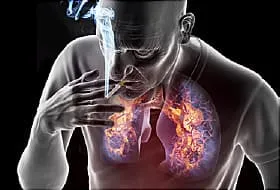From your bones to your bladder, smoking can damage just about every part of your body. And your lungs are front and center.
Smoking is far and away the leading cause of lung cancer, even for nonsmokers who get it from secondhand smoke. Just a few cigarettes a day -- or low levels of secondhand smoke -- can hurt your lungs.
And don’t be fooled by low-tar or filtered cigarettes -- they don’t make a difference. The more cigarettes you smoke a day, no matter what kind, the higher your chances of having lung cancer. The number of years you smoke has an even bigger effect. So the sooner you quit, the better.
But your body has an amazing ability to heal. Within just hours of your last cigarette, your health starts to get better. And if you quit, after a few years, your odds of getting cancer, heart disease, and other illnesses start to drop.
The Link Between Smoking and Lung Cancer

Other chemicals in cigarette smoke make the cancer-causing ones sticky, so once they attach to your genes, it’s hard to get them off.
Smoking also causes swelling in your lungs. When that happens along with the gene changes, that’s like putting a heavy foot on the gas pedal of cell division, making cancer even more likely. Still other chemicals in tobacco smoke keep your body from fixing the broken genes.
How Does Secondhand Smoke Affect Your Lungs?
Secondhand smoke comes in two forms:
- Mainstream smoke that the smoker breathes out
- Sidestream smoke that comes from the burning cigarette or cigar
With secondhand smoke, you breathe in the same chemicals as the person who’s smoking, and they have the same effect. It doesn’t matter to your lungs how the smoke gets there -- it can cause lung cancer either way.
There’s no safe amount of secondhand smoke. Even a little is bad for you. Just as with smoking, the more secondhand smoke you take in and the longer you’re around it, the higher your risk of lung cancer. Living with a smoker can raise your chances by as much as 30%.
What About Vaping and E-cigarettes?
These work differently than regular cigarettes: A battery heats up a liquid, and that makes a vapor you breathe in. (That’s why it’s called vaping.)
With vaping, you don’t get tar, carbon monoxide, or many other harmful substances you get with regular cigarettes. But you typically still get nicotine, the chemical that makes them so addictive.
Generally, it seems that e-cigarettes and things like them are safer than smoking, but that doesn’t mean they’re safe. Studies have shown that some chemicals found in e-cigarette vapor, like formaldehyde, are linked to head and neck cancers.
Some studies have found that e-cigarette vapor may cause inflammation in your lungs and may have very tiny particles of chemicals that cause cancer. Because they’re so small, these particles can get deep into your lungs.
The flavored liquids used for vaping are also a concern -- some cause stress in your lungs and are toxic to lung tissue.
Even secondhand vapor has health risks: Some research links it to higher rates of lung infections in young people.
Can Marijuana Lead to Lung Cancer?
Because it’s been illegal, it’s been hard to do research on it. Like tobacco, it does have tar and other chemicals known to cause cancer. So while there could be a link between smoking marijuana and lung cancer, there’s not enough research to know for sure.
By the Numbers: Smoking and Lung Cancer
If you’re a numbers person, consider:
- Tobacco smoke has about 250 harmful chemicals, and at least 69 of them can cause cancer.
- Men who smoke are 23 times more likely to get lung cancer, and women who do are 13 times more likely than nonsmokers.
- In the U.S., lung cancer from smoking causes 130,000 deaths a year, and another 7,300 people die from lung cancer caused by secondhand smoke.
- People who don’t smoke are 20% to 30% more likely to get lung cancer if they live or work around secondhand smoke.
Tips to Quit
Whether you smoke or vape, nicotine gets you hooked, so quitting isn’t nearly as easy as starting. Here are some tips that might help:
- Create a plan: Choose a specific date to quit, set goals, and think about how you’ll hold off when the cravings kick in.
- Know your cravings: Maybe you want a cigarette when you eat. Or at parties. Or when you’re stressed. Make a list of your triggers and try to stay away from them or figure out how you might handle them differently.
- Keep busy: When cravings come on, it helps to have something to distract you. From knitting to woodworking, you’re less likely to light up if you can keep your hands busy.
- Make a list of reasons to quit: Saving money, whiter teeth, more energy -- whatever your reasons, make a list of them and read it every day.
- Find support: It’s tough to kick the habit alone, but others can help -- a good friend, a loved one, or a support group, for example.
- Talk to your doctor: They can suggest medicine or programs that might work for you.
- Reward yourself: Quitting is hard work -- give yourself a treat when you meet a goal or resist a craving.

